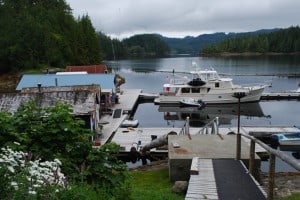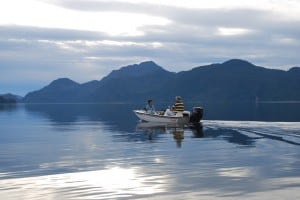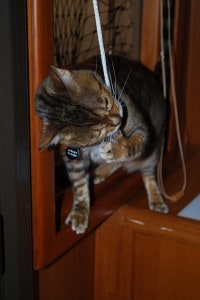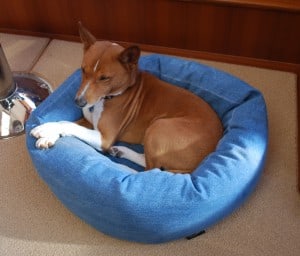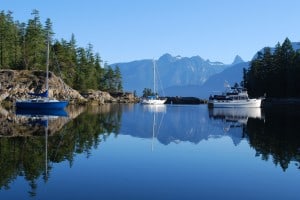September 3, 2011
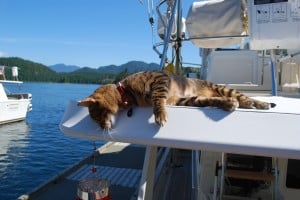
This is one plausible explanation for why it happens – she loses track of her center of gravity. Another is that she loses her footing on the slippery fiberglass. Still another is that a pesky seagull swooped at her and she zigged when she should have zagged. Who knows? All we heard was a plop when she hit the water.
Teabag (a.k.a. ZuZu) has had another cold saltwater dip. This is her third plunge into the frigid 50° waters in these parts, and her adventure really alarmed us.
We were tied up at the Seattle Yacht Club outstation dock in Cortes Bay, near Desolation Sound, and were both getting some stuff done on our laptop computers – Kap in the pilot house and me at the salon table – when Kap suddenly cried out, “ZuZu’s in the water!”
Boy, that statement really energized me, and I raced out the salon doors to the cockpit and around to the starboard side walkway. I looked down into the water along the side of Flying Colours, and sure enough, there was ZuZu swimming like an Olympic champion. She was looking up at me, wide eyed, but making an incredible pace through the water, heading straight for the aft end of the boat and the swim step. By the time I could run back to the cockpit, open the transom door and step down onto the swim step, ZuZu was there and had propelled herself out of the water and up onto the swim step. Like a lightning bolt, she shot through the transom door and raced up the side walkway on the port side, around the Portuguese bridge, and into the open pilot house door on the starboard side that Kap had just come through. She then bolted up the five steps to the fly bridge, and when I got there she had already briskly shaken herself and was crouched beside some pillows on the settee, looking like a drowned rat.
Kap arrived with a towel and managed to get it wrapped around her. We took her to the cockpit – by now I’m sure she knows what the drill is – to hose her down with fresh water so she won’t get sick licking herself dry of the salt water in her fur.
Yes, she managed to get me once really good with her hind claws – a deep rake across the left wrist that was reminiscent of the San Diego Airport scene last January. I can’t say as I blame her – the fresh water from the cockpit hose is cold too, and this definitely isn’t one of those summers where a cool rinse-off feels good.
We don’t know how she did it, but luckily Kap heard a light bang against the hull and the loud splash in the water. ZuZu was up on the dinghy deck, which is a good 15’ above the water line, and might have just gotten too cocky about her fancy footwork. Or maybe the waxed fiberglass might have been too slick for some little jump that she tried. Or, there’s a possibility one of the nearby seagulls might have swooped down on her – we see them keeping an eye on her, and maybe one of them decided to take her out.
We later found two scratch marks in the main deck teak railing at the spot where she fell, and it’s obvious she managed to get a paw and a couple of claws onto it as she fell. That must have really given her a whap on at least one leg. Below that near the water line is a fiberglass rub rail that she then likely hit. She was definitely nursing her bruised body and ego the rest of the day, but now seems no worse for wear. What’s most interesting about it is, her coat is softer than velvet – makes one wonder if a salt water bath for cats could be bottled and sold. Hmmm, maybe we could make our fortune?????
I am getting worried, though, as I’m the only one on Flying Colours – including Gator – who hasn’t had an unexpected dip in these waters. I’m watching my back.
But I’m getting ahead of myself. . .
Click on any image to see an enlarged version of it.
Wednesday, August 17th, Booker Lagoon Anchorage To Jennis Bay Moorage
When I last left off, we were just departing Booker Lagoon, planning to head for Jennis Bay. Well, we did, and we had two really great nights there.
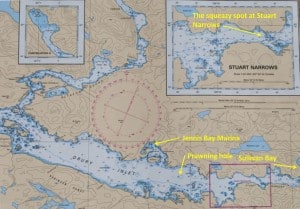
Here’s the nautical chart of Drury Inlet. Stuart Narrows is at lower right (and enlargement at top right), and you can see the narrow, rocky, shallow bit that sets up the strong current during tidal flows. It’s about 3 miles up the inlet to Jennis Bay, tucked in behind an island, and you wouldn’t even know it was there without the chart. Along the way, we searched for and found a pretty good prawning hole, right at 300’ deep.
Jennis Bay is about 3 miles up Drury Inlet, in the northwestern corner of the Broughton’s – a dogleg inlet that pierces into the mainland almost 20 miles, with old logging camps dotting the area. You have to pass through Stuart Narrows to get there – and as the name implies, it’s narrow, and therefore, the current runs fast with the tide changes. It’s one of the places we avoided in our early years coming here, as frankly we thought it was just too narrow to feel comfortable. And with good reason – just inside the Narrow’s entrance is a memorial marker for two guys on a tug towing a barge – the barge was found in the middle of the Narrows, running full speed in tight circles, with no sight of the two guys, presumably drowned when the tug, for whatever reason, didn’t make it through the Narrows.
As it turns out, Kap’s comfort level with narrows and rapids these days is very good (i.e., really good common sense), and we just don’t have the frightening tales that others have about this.
As we motored further into Drury Inlet we kept a keen eye on the depth sounder and paper charts, looking for the magic “holes” around 300’ deep – places where we might get some prawning in. Sure enough, about a mile from the entrance to Jennis Bay we spotted an oval shaped hole, and mentally mapping it as we cruised over it, we knew this was one to ask the locals about when we got into Jennis Bay.
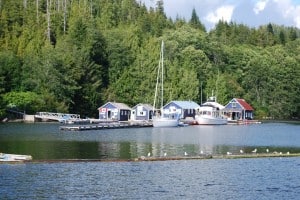
Jennis Bay Marina as we approached it. There were just two other boats at the dock when we arrived, and another small fishing boat came in shortly after us. We were directed with Flying Colours to the other side of the dock from the Grand Banks and the sailboat. This is the site of an old logging camp from the late 40s and early 50s, and the founder, Allyson Allo, grew up here when her father was helping to build the camp.
It was Wednesday, and Tuesday is their big jambalaya night potluck, and it’s always crowded then – so we figured there was a good chance there’d be room for us. I had sent an e-mail the day before telling them we were arriving and they said they’d have room, but oftentimes it’s still first-come, first-served. As we rounded the island almost blocking the entrance to the bay, we could see that their dock was tiny, with two boats already on it, but looked like there was room for us. On the VHF a woman’s voice said to come around to the left of the log breakwater and we’d have a port side tie, bow out – which is exactly what we needed if we were to get the dinghy down for prawning.
Sure enough, a woman who introduced herself as Karen met us at the dock and took our lines. She was extremely friendly, and told us it was “her month” to fill in for her sister, Allyson, who was away settling up a divorce. Karen’s husband, Joe, soon joined us, explaining that there was no shore power or fresh water at the dock – which we already knew, so you’re on battery power and generator to keep things running. They also said Happy Hour was at 5PM on the covered float behind us.
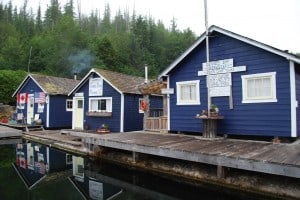
The old float buildings at Jennis Bay are really quaint. As with most other marinas in the Broughton’s, few of the float buildings are native to the particular site where they’re currently moored – they get hauled around from site to site as needed. All of the buildings at Jennis Bay are at least 50 years old, and they’re floating on old growth logs that are reaching the end of their lives (i.e., starting to sink from being totally water logged). The cookhouse is the building to the left, where coffee and hot muffins are served each morning. A gift shop is in the middle building, and the bunkhouse for guests is on the right.
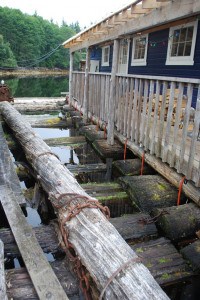
This photo is a good example of the float logs that are typical here – the ones beneath the bunkhouse are at least 40-44” in diameter, and being the same diameter at both ends, they must have come from very large trees. Nowadays, there’s a guy near Port McNeill who specializes in building floats and buildings to sit atop them, and he uses foam blocks and sealed fiberglass boxes for floatation, as they last almost forever and are more evenly stable.
Happy Hour was fun. Karen whipped up a plate of baked brie, with a salmon berry sauce drizzled over it – I’ve never been wild about brie, but with the sauce it was good. There were also two dozen just-cooked spotted prawns with cocktail sauce, and sure enough, they’d been pulled up that afternoon from the hole we had spotted.
With the divorce of the owning couple going on, we’d heard that the jambalaya night wasn’t being held this summer, but Karen and Joe assured us that wasn’t so – they’d had 40 people at the previous night’s dinner, and the marina was filled to the brim with boats – and that would have to be at least 12+ boats. We couldn’t imagine where they put that many boats, as there were only four now at the docks, and it didn’t look like more than two more would fit. It’s amazing, though, how some of these marinas pack them in.
First thing next morning, we got the dinghy down, loaded it with the prawn trap glimp, got suited up in our flaming orange suits (more to keep warm than anything else, as early morning temperatures are still in the low 50s), and headed out to drop our traps.
There was already a prawn buoy at the eastern end of the hole, so after driving around to find the absolute deepest spot in the hole, yet away from the other buoy, we baited up and dropped our two traps in about 325’ of water.
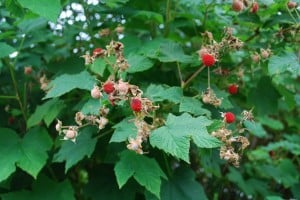
When I went onshore to get the photo of Flying Colours, I found a thimbleberry bush – the first I’ve heard of them. The berries are edible and taste like a raspberry (and they’re related to raspberry and blackberries), but more delicate in flavor.
Imagine! On our return from setting our traps, and after just one night as guests at Jennis Bay, Kap and I were put in charge of the place to run it for the remainder of the day! We must have honest faces, or maybe we act like we know what we’re doing……
Actually, we were now the only boat expected to be there that day and night, and Karen and Joe had plans to motor over to Echo Bay to inspect a float home they were thinking about buying. On their return, they were stopping at Sullivan Bay for dinner – and their first night away from Jennis Bay in a month. We told them we’d be happy to look after the place, but that they needed to double our $0/hourly wage they were offering to pay us.
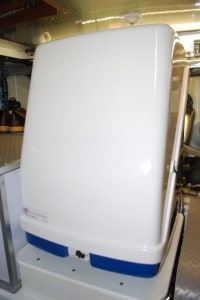
One of the nicest things about a new boat is new systems and equipment. One of the best pieces of equipment on Flying Colours is our WhisperGen. Built by a company in Christchurch, NZ, it consists of a Stirling diesel engine that generates 800W of AC electrical power when it’s running. This electricity is then routed through a DC generator for charging/maintaining our house bank of batteries that we use for our everyday needs aboard Flying Colours. (The Stirling engine, invented in 1816, is vastly different from a combustion engine, with no “explosions” going on inside, so they operate very quietly, with no exhaust gases – if you’re interested you can read more about it at www.howstuffworks.com/stirling-engine.) Our WhisperGen is about the size of a home kitchen oven, inside a stylish case to make it look pretty, and basically sits unattended in Flying Colours’ engine room. Electronic controls inside it monitor our very large bank of “house” batteries (i.e., the batteries that we use for all DC systems aboard the boat), and start up the Stirling engine whenever the battery voltage drops below a threshold. Its sole function then is to top up the charge on the batteries, and if/when they reach full charge it shuts down again. When it’s very quiet aboard Flying Colours we can barely hear it running, and it’s so automated we could go for weeks without even thinking about it – and it burns 1/5th of a gallon of diesel per hour when it’s running. (Unfortunately, the company’s research and manufacturing operation was virtually destroyed in the huge Christchurch earthquake this spring, shutting down operations and wiping out their entire inventory. Since then, they’ve rebuilt much of their operations, but as of now they are no longer producing the “off grid” unit such as we have on Flying Colours. When we installed our WhisperGen, we purchased their complete spare parts kit, so we’re hoping this will enable us to withstand any repairs that might be necessary on our unit in the future.)
As a prelude to a later part of this post, in mid-afternoon while I was sitting in the cockpit taking life easy and reading a book, I suddenly noticed an acrid smoke smell wafting in from the port side of Flying Colours. I then saw smoke curling over the cap rail, and I’ll tell you, I jumped to my feet in an instant. At the same time, two other guys onthe dock smelled it too and they came rushing over – fire on a boat isn’t a pretty business, and it always gets everyone’s attention. The smoke was coming from the WhisperGen exhaust port – a fancy gizmo in the engine room whose primary function is to monitor our house bank batteries, and when they reach a certain voltage limit, it fires up and charges the batteries. (See quite a bit of information in the photo and caption sidebar about this.)
To our suprise, late in the afternoon we spotted a cruising boat motoring into the bay. With our binoculars we could tell it was a classic old wooden motor boat, but it was too far away to read the name plate on the side of the house. There wasn’t a radio call from them, nor could we raise them on the radio, so we just stood on the dock and acted like we knew what we were doing. As it neared, Kap said, “That isn’t the Puget Lady, is it?” I told her no, it couldn’t be, as the lines just weren’t right. As it neared the dock and turned 180° to get a starboard side tie, sure enough, it was the Puget Lady – and I could see our old friend, Tom Magwire, in the pilot house.
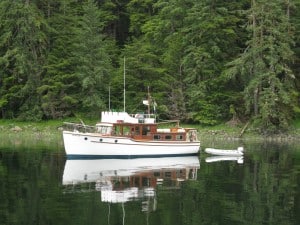
This photo of Tom Magwire’s classic wooden boat, Puget Lady, was taken in 2008 when we were anchored in a tiny bay at Claude Point on the top end of Revillegigedo Island (the island that Ketchikan is on). Many years ago, Tom and a friend built a kayaker’s overnight cabin on the shore in this bay, and Tom spends a few days here each time he’s in Ketchikan to fix up whatever needs to be done on it. We had just ended a circumnavigation of Revillegigedo, visiting Misty Fjord across from the east side of the island. We decided our meeting at the cabin would be the First Annual Arctic Bar Yacht Club meeting . . . but it turned out to be the last too, as we all got too busy and didn’t carry through with it.
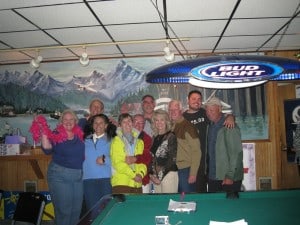
After the late-night decision to create the Arctic Bar Yacht Club, we all posed for a founders group photo. Tom is at center rear, and his business partner and friend, Paula is at left. Next to Paula are our good friends, Bucky and Christy Wood from the American Tug, Undoc’d – Bucky is a retired surgeon from Birmingham, AL, and this was their first-ever year of cruising. To our left is Marty and Linda Ellison, who cruise on a 47’ Nordhavn, Tenacious – and the live just south of us in Bellevue. Tom’s son is in the black T-shirt, and Tom’s friend, Kevin, is at far right. Hey, all you guys in the photo – we miss you, and look forward to getting together again!
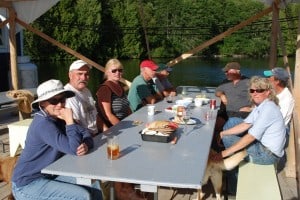
Happy Hour at Jennis Bay. Our Ketchikan friend, Tom Magwire, is at right rear. I failed to get a photo of the yellow Lab whose butt you can just see sticking out from the end of the table. This is the marina’s official dock-greeter dog, but his claim to fame is losing an eye to a cougar a few years back, defending the place. When our friends, Steve and Shirley, were here five years ago, he still had the stitches closing his eye, and the marina owner’s two young girls were passing a hat around to all of the boating guests to help pay for the huge vet bills.
I say old friend – actually, we met Tom in 2008 in Ketchikan, where he’s half-owner of the Arctic Bar, the home of the happy bears (to see what I mean by happy bears, take a peek at their web site, www.arcticbar.com). We’d met Tom – and his longshoreman-mouth partner, Paula – at a raucous Dessert Auction to raise money for the Ketchikan Arts Council on our arrival night in Ketchikan on our 2008 cruise to SE Alaska. Tom lives in Port Angeles (Washington), and cruises up to Ketchikan almost every summer to do fix-up work on the bar, and to help out with whatever work Paula needs done. With our four other cruising friends that we were buddy-boating with, the dozen or so of us were the founding members of the Arctic Bar Yacht Club – but unfortunately, it never really got off the ground. We hadn’t seen Tom since.
Over Happy Hour that night, we caught up on old times with Tom on what we’ve been doing since we last saw each other in 2008. He still co-owns the Arctic Bar with Paula, and tries to get up to Ketchikan every summer – but not this summer. He said he’ll hang around the Broughton’s for a month or so, and we’ll probably meet up somewhere as we head south.
Prawning at Jennis Bay wasn’t bad – 80 and 81 for the two trap pulls – and they were surprisingly large.
Friday, August 19th, Jennis Bay Marina Moorage to Moore Bay Anchorage
We stayed two nights at Jennis Bay, and as luck would have it, there was pea soup fog when we awoke on the second morning. Slack water at Stuart Narrows was at 10:30AM, so we really needed this to burn off if we were to go through for our next leg – the plan was to head for Moore Bay and hopefully meet up with Couverden.
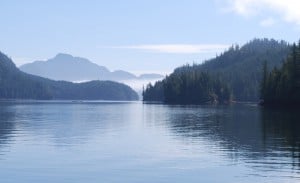
The view of Jennis Bay looking from the dock towards Drury Inlet (the narrow slit between the two points of land). The fog had just lifted and we were set to go.
As we pulled our prawn traps, the fog started to lift a bit and that was encouraging. By the time we got back to Flying Colours, stowed Hinky (that’s actually the name of the dinghy – if anyone can guess why it’s called Hinky, we’ll send you a Flying Colours T-shirt) on the dinghy deck, and settled our moorage account, the fog had lifted and we were good to go.
Kap timed slack water perfectly, and we passed through Stuart Narrows with flat calm water. While Kap managed the helm, we cruised through Patrick Passage, then Sutlej Channel, headed for Moore Bay near the entrance to Kingcome Inlet. I settled in at the salon table to shell, vacuum seal, and freeze the catch of prawns from the day before.
We’ve heard a lot about Moore Bay this summer, first from a couple from Vancouver that we met in Beaver Inlet at the start of our prawning season. They told us they were hauling up 300 prawns each pull, and max’d out their limit in a couple of days. We hadn’t seen more than about 80 in our traps so far, so we were anxious to give this a try. We were in touch via e-mail with Steve and Shirley on the Couverden, and they expected to arrive a few hours after us.
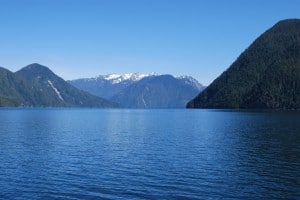
Moore Bay may not have been the greatest for prawns during our 2-night visit, but the view was certainly spectacular. From our anchorage we had an absolutely stunning view up Kingcome Inlet, with mountains on the Canadian mainland that have permanent snow caps at the higher elevations.
Moore Bay is on the Canadian mainland, at the end of a long peninsula that juts out to the west. The fairly large Gregory Island sits at the opening, and inside the bay there are several small islets – just big rocks covered with trees, actually. While the bay is quite large, there aren’t many comfortable places to anchor, and luckily, there wasn’t a single boat in the bay when we arrived. We cruised around looking for a good spot, but it was deep – up to 150’ in many places – right up to the shoreline. We located two mooring buoys near a government Forest Service dock, but we didn’t trust them to hold a 70,000 lbs boat like Flying Colours.
Finally, we settled on a tiny bay within a bay on the west side of Moore Bay, where we found 30-40’ water near the shoreline – and maybe too close to the shoreline. At the point where we were as close to shore as we felt comfortable, there was a steep drop-off from 40’ to almost 100’ in a matter of about 100’ distance. With Kap at the helm and me at the windlass, we decided to drop the anchor at 40’ depth, bow out, and then back towards the shore as we let out scope. It was totally calm when we anchored, but we were still nervous about dragging the anchor to deeper water than we had chain out for if a NW wind came up, and finding ourselves on the shore rocks if an Easterly came up. It was a dilemma, and that’s what always makes anchoring interesting (and challenging).
The Couverden arrived shortly after we set our anchor, and they too had a challenge finding an anchorage they felt comfortable with. They finally settled on a tiny shoreline indentation on the opposite side of the bay from us. While they anchored, Kap and I headed out in Hinky to find a good spot to set our traps. We searched throughout the bay, but none of the spots that were anywhere near 300’ matched the description by the Vancouver couple who told us how great the prawning was. After driving around for 30 minutes, we settled on the edge of a large square-shaped hole that was just over 300’. There were two other prawn traps there, and we hoped their owners knew the best spot (they must have been set by someone through a tiny passage from us that goes to Shawl Bay, where there’s a marina we visited in 2007 and hadn’t been back to since).
Steve and Shirley had other ideas – they set their traps quite a distance from us – and that didn’t bode well for us, as Steve seems “to be one” with the prawns, and instinctively knows the best places. We decided to pull our traps in late afternoon to see how we did – a big zippo! This was the first time in a year we’d come up completely empty-handed, and what a disappointment. We re-baited our traps and headed for the area where Steve set theirs.
Next morning, we had 49 prawns in our trap, which is certainly better than zero, but it was one of the lowest pulls we’ve had this summer. We moved again, and had a skimpy 38 prawns this time – and there were large numbers of Coon Stripe Shrimp, and we haven’t decided if we like them as much as Spotted Prawns.
On our second or third pull at Moore Bay, a crab showed up in our trap – Helmut crab, or a Lyre Crab. At Booker Lagoon we had a Sunflower starfish in each of our traps – the starfish that I cleared was easily 16” across, and must have weighed 5+ lbs.
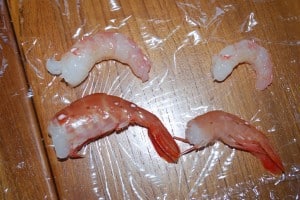
The prawns in the Broughton’s definitely come in two sizes, mixed almost equally – what I’m calling large and medium. I’m guessing the large are 2-year olds and the medium are 1-year olds and before molting into their new harder shells.
Notice To Readers: I’ve gone totally overboard in my following discussion about Spotted Prawns and Coon Stripe Shrimp. If you don’t care to read this, be my guest and skip to the end of the discussion – annotated by a line of ******.
Starting with Beaver Inlet back in mid-July, we found one or two striped prawns in our traps – whereas all the others were spotted (about a 25-to-1 ratio of spotted to striped). They otherwise looked quite similar, but when I shelled them I found their shells to be very different – a much more delicate shell, and the flesh seems to be more delicate. We soon learned these are Coon Stripe Shrimp – not prawns, but shrimp – and they were always much smaller . . . so much so that we sometimes threw them back as we emptied our traps, figuring they were increasing our caught number towards our limit and were substandard. When we got to Moore Bay this week, we found that the striped were almost equal in number to the spotted prawns, but much larger in size. One guy we talked to said he actually preferred striped to spotted, claiming they were “sweeter” (I’ve never figured out how anything coming from the sea can be classified as “sweet”, but then I guess that’s my land-food bias.)
Later, at Kwatsi Bay, Kap picked up a very expensive book at their tiny gift shop – called Marine Life of the Pacific Northwest – and it told all about the various prawns/shrimp that we’re encountering. According to the book, Coon Stripe Shrimp (also called King Shrimp or Humpback Shrimp, because they have a prominent hump to the back of their body) are very similar to Spotted Prawns (which are also known as Pacific Prawn), and are said to taste very similarly. We can’t seem to get a definitive statement on the difference between “prawns” and “shrimp” – as the Coon Stripe are called shrimp, whereas the Spotted are known as prawns. I always thought size had something to do with it, but that definition seems to be going out the window.
Another interesting thing I’m finding has to do with the shell of the Spotted Prawn. As you may recall, our technique (learned from Steve on the Couverden) is to rinse the prawns as soon as we get them back to Flying Colours (and their heads have been snapped off back where we brought up the traps). I then rinse them (twice) in fresh water, and put them overnight in the fridge (25 – or so – to a plastic container). This cooling down does something to the way their shell is attached to the fleshy part of their body, and when they’re shelled the next day, the shell can be more easily peeled off. Well, having peeled over 1,500 shrimp this summer, I now sort ours into two sizes – medium and large. As I peel them I separate the large from medium, and vacuum seal 20-24 (or so) large to a ZipLoc-type bag and 26-28 medium to a bag. (The idea being, the large ones are great for a prawn cocktail or cooking on the BBQ, whereas the medium ones are perfect size for Scampi.)
What’s interesting about this is, the shell casing itself is very different between the two sizes. Turns out, Spotted Prawns live about 2½ years, and molt somewhere in between. My guess is, the ones I’m calling medium are still in their first shell, and the large are in their new shell after molting. In the Spotted Prawn world, even the young ones have a firm shell, but it’s not difficult to get my thumbnail under it, peel it around, then get the next shell wrap and do the same, crashing my thumb through the little flipper legs on the underside of the belly. With the large ones, though, the shell is significantly more firm, and I have to be much more careful and specific with actually peeling each shell wrap – and the flipper legs are much more firm and cannot be “crashed through” with my thumb.
Lastly, I’ve found that the purpose of the two white “spots” a Spotted Prawn have seems to be a cartilage-like spot weld, where the shell is attachedto the body flesh of the prawn. When I peel the Spotted Prawn, whether large or medium, I have to be very careful to force the shell to break away from the two spot welds. There seems to be nothing about this in the books that we’ve looked at, but with my experience in numbers, I believe I’m right about this. (The Striped Coon Shrimp doesn’t have these “spots”, and the shell seems to be wrapped around the flesh in such a way that it isn’t “welded” to the flesh.)
********************************************************************
A drawback to Moore Bay is the total lack of cell phone coverage or Internet access. With everything going on in our lives right now, about two days is the most we can be totally out of range, so we decided to dinghy across to the next bay to visit the Shawl Bay Marina. We’d briefly stopped in there on our 2007 cruise to the Broughton’s, but quickly decided it was a bit too disheveled, plus the owner’s large dog took a liking to Gator and sat outside our boat on the dock the entire time we were there, driving Gator crazy.
We didn’t find cell phone coverage, but sure enough, they had Wifi available to guests for $5 – but they were closing it down in 45 minutes (presumably to lower the load on their generator). I knew I probably had 100+ e-mails, plus Kap needed to access an internet weather site as she hadn’t been able to get good weather data via our VHF radio on Flying Colours.
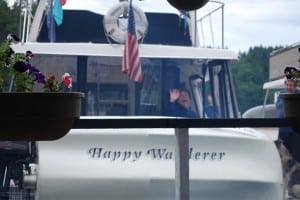
The lady who couldn’t find her camera – because it was in her pocket – waves goodbye to us from the Happy Wanderer as they pulled away from the dock.
As we worked away on my computer at one of the Happy Hour tables, racing to get e-mails and weather data downloaded before they shut down, a gal about 80 years old from a boat right in front of us stopped by and asked if we’d seen her camera.
“What does it look like?” we asked.
She reached in her pocket, pulled out a camera, and said, “It looks just like this!”
Realizing immediately what she’d just done, she blurted out, “Silly me! I’m the ditzy woman on that boat over there!”
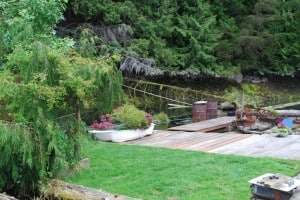
One thing we found at Shawl Bay – the best dog potty float in all the Broughton’s (the grassy area in the foreground is actually part of a float). Maybe it’s because virtually every boat in the marina had a small floor mop dog aboard – that seems to be the type of breed for the older set – and they demand a better place to walk their dog.
It didn’t take us long to figure out that Shawl Bay Marina caters to the geriatric set. There wasn’t a single boat in the marina – and there were at least 20 boats at the dock – that wasn’t crewed by couples in their late 70s and early 80s. That’s great to see, but it’s unusual, and seemed like they come here for the summer and just hang out – sort of like snowbirds going to Arizona for the winter.
Back at Moore Bay, by our third prawn trap pull, we’d come to the conclusion that this area had recently been fished out, and we really had no reason to stick around.
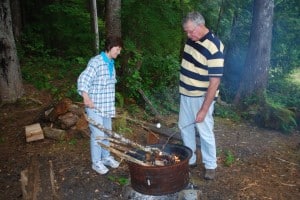
Steve and Shirley roast marshmallows over the fire pit at the Forest Service picnic area in Moore Bay.
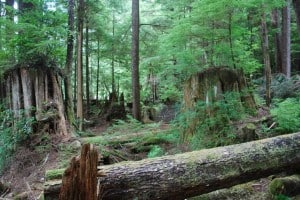
At the edge of the picnic area there were huge old growth cedar stumps, with fallen cedar trees everywhere. We’re told that in the early logging days cedar trees were considered junk, and cleared out so they could get to the more valuable Douglas Fir trees more easily. These old cedars are now nursery stumps and logs from which new trees have grown from.
On their way to Moore Bay, Steve and Shirley stopped at Echo Bay Marina for provisions, and Steve stocked up on S’mores fixin’s for a shoreside bonfire on the last evening. We dinghied over to the Forest Service dock and found several freshly painted picnic tables, each with a nearby fire pit in which we could build a safe and sane fire. While getting eaten alive by the no-see-ums, we roasted marshmallows over the fire, then tucked them between layers of graham cracker and chocolate. Washed down with a glass of red box wine, plus a nip of Drambuie to finish off the evening, it was a perfect ending to a not-so-perfect – but nevertheless very enjoyable – stay at Moore Bay.
Sunday, August 21th, Moore Bay Anchorage to Kwatsi Bay Marina
Just before 5:00AM, Kap and I both awoke to the sound of our anchor chain rumbling over rocks – and we could also hear high winds outside creating waves that were rocking the boat. We bounded out of bed to see if we might have pulled up our anchor. Visually, our distance from shore was still pretty much the same, but our depth sounder indicated we were sitting in 70’ of water – and when we looked at A-oh, our anchor sentinel bobbing in the water, we could see that “he” was still in the same location. If the wind blew us any further offshore, though, it would likely pull our anchor off the shelf and we’d be adrift. Interestingly, the waves were pushing us toward shore and the wind was pushing us offshore, and for the moment they seemed to be counterbalancing each other. Nevertheless, we decided it was time to get the hell out of there.
We were damn glad we’d made the effort at almost darkness the night before to raise Hinky to the dinghy deck, so there wasn’t much to do in getting ready – and we weren’t doing it in the current nasty weather conditions. After starting the engines, and with Kap also at the bow, I first raised the anchor enough so she could grab A-oh’s line with a boat hook to keep it away from any underwater running gear, then I raised the anchor. Back at the helm, Kap immediately steered us out to safer water. It was the first chance to catch our breath in 30 minutes of high anxiety. Just as we stowed the anchor paraphernalia, we saw Couverden making their way out of Moore Bay. They were heading for Port McNeill – the opposite direction from us – and we hailed them on the radio to wish them a safe journey.
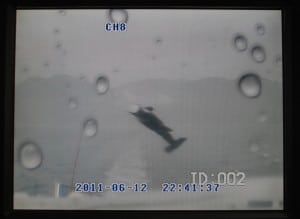
Wow! It’s a great underwater shot of a Killer Whale . . . well, OK, it’s a raindrop spotted camera lens in the fly bridge, looking aft at our wake as we traveled down Tribune Channel in the rain. The Killer Whale is the inflatable kind, a kite connected to a pole to keep eagles from scooping ZuZu up from the deck.
The cruise down Tribune Channel to Kwatsi Bay was uneventful – the rain continued, but the wind calmed considerably and the water was less than 1’ chop. We arrived at Kwatsi Bay just after midday, and while it was good to see Anca and Max as they helped us onto the dock, it was raining too hard to be sociable and we puttered around inside.
Actually, it poured all afternoon, into the evening, and all of the next day. It had already been raining for more than a day,
Anca said that tonight was a potluck dinner night (every other night is potluck, the other night is just Happy Hour with appetizers). I’d been hoping for Happy Hour with appetizers, and had something all ready to bring – now I had to switch gears and figure out what to bring. Kap’s advice was, “it’ll all be fine, just wing it from what you find in the fridge”.
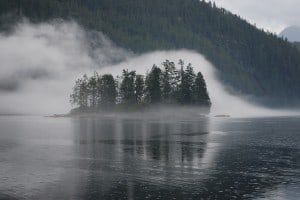
The fog at Kwatsi Bay Marina is always interesting – swirling around and over the small island just off the docks at the marina. This photo was taken at 4:30PM, in heavy rain (as you can see from the splatters in the water), and that’s most unusual.
Shortly after we arrived, a trawler called the Intrepid pulled in and tied up directly behind on the dock, stern-to-stern with us. On the way in, Anca yelled out congratulations to the woman at the side rail as she readied the bow line to toss, “Hey, you’re now a published author!”
It was then I recognized the woman from last year at Kwatsi when we were in, and also knew that she was the author of a just-out paperback book I bought at the General Store in Sullivan Bay – called Last Resort. The author is Rolynn Anderson, a long-time cruiser here, and she’s been dropping off copies of her first-ever novel to all of the resorts (www.rolynnanderson.com). After they tied up, I invited her over to sign my copy of the book. Rolynn was ecstatic to do it, excitedly telling me that she’d been asked to do a book signing at the nightly theme dinner at Echo Bay Resort the night before and she’d sold 20 copies. She was almost jumping out of her skin at excitement over this.
Rolynn has been a high school English Composition teacher for most of her career, and always knew she needed to write a novel to prove to herself that what she was teaching really worked – and now she’s done it. She explained that it’s a romance/mystery/thriller, published by The Wild Rose Press that specializes in romance novels, but then added, “You guys will love it too . . . it even has helicopters in it!” I’m not into romance novels at all, but from the titles in the lending libraries at each resort in the Broughton’s, I think it’s the most widely read genre by the women cruisers.
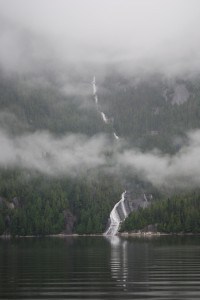
Three days of heavy rain created wonderful waterfalls – this photo is at Lacy Falls on Tribune Channel, a mile or so before you turn into Kwatsi Bay. For the past several years, this hasn’t had but a trickle of water – if any at all – but with the recent rains it’s living up to its name.
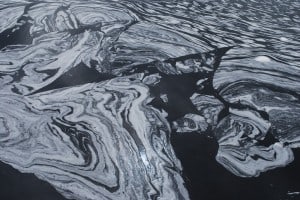
Several waterfalls sprouted behind us on the sheer cliffs at the head of Kwatsi Bay, one of them emptying out in a gushing stream on the shore just 100’ from where we were moored. It created a mass of foam on the other side of the dock from us, which then trickled under the dock and encircled us. Looking down at it from the deck of Flying Colours, I would have guessed it looked more like the ice floes around Iceland and Greenland that I’d often see from 38,000’ on Polar Route flights from London to Seattle – the geometric patterns didn’t look like they could be foam from a waterfall on shore.
All afternoon long, the rain bucketed down, intensifying as the day progressed. In no time, the stream on shore near us was gushing and the sound of the waterfall behind it drowned out everyone’s generator. The outflow was so intense that it created white foam everywhere on the water’s surface. It was a good day to stay inside and read a book, write, or play on the Internet.
In the evening, Max and Anca hosted their every-other-night potluck dinner on the covered Happy Hour float just opposite where Flying Colours was moored. Kap and I are usually not wild about potluck dinners, but this was one of the best we’ve been to in a long time.
While Anca was on the dock most of the afternoon orchestrating arriving boats, Max whipped up a noodle pasta with sausage and dried tomatoes, plus a large dish of curried baked chicken drumsticks – both delicious. I decided to wing it with a country fry potato hash, with chunks of Black Forest ham sprinkled in, and finished off under the broiler with melted cheddar cheese on top. For such a mundane dish, it seemed to be a hit, as it was among the first to be gone. Rolynn brought her Broadway Pea salad – from the old Broadway Café on Broadway Avenue in Seattle – and it was so good I’ve asked her for the recipe. There were three or four other dishes that were really good. For some reason that isn’t true at most other resort potluck dinners, but the cruisers really go out of their way to make good dishes here at Kwatsi. We don’t know why.
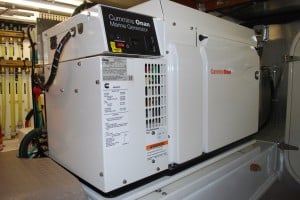
Our primary generator (known as the “genset”), a 17KW – i.e., it puts out 17,000 watts of power – sits in the engine room, and does most of the heavy “lifting” loads, running the high-load electrical systems (220V AC systems) such as the water maker, the galley cooktop stove and dishwasher, the water heater, and entertainment system when we’re not on shore power. Inside that shiny case is a fairly substantial diesel engine, but it’s efficient – barely sipping 1 gallon an hour of diesel.
The next morning dawned clear and dry, and we thought maybe we were back to another day of summer – which seems to be the pattern this year. Our plan had been to get the dinghy down to set our prawn pots, as we’d heard earlier that the prawning was good at Kwatsi. Anca told Kap at Happy Hour, though, that the bay had been prawned out, and the only decent place to get prawns right now was past the end of Kwatsi Bay, then across Tribune Channel to Wahkana Bay. That’s a 4-5 mile trek in the dinghy, and if the winds are blowing down Tribune Channel it can be rough. We decided to give it a miss, and just take life easy, and both of us spent most of the day on our computers. I still had one last batch of prawns from Moore Bayto peel, vacuum seal, and get in the freezer, which pleased ZuZu to no end as she got her “prawn nectar” juices at the end.
In the middle of the afternoon, I noticed acrid exhaust smoke rising from the port side of Flying Colours – at the location of the WhisperGen exhaust – same as two weeks earlier at Jennis Bay. Two other cruisers chatting away on the dock noticed it just as I did and came running over, thinking it might be a dreaded boat fire. It certainly burned the nose, and I asked Kap to immediately kill the WhisperGen. Sure enough, it was a failure, with a “flame fault” indication on the panel, same as before. Then, though, it seemed to clear itself when the unit was restarted. This time, it belched more smoke, plus it filled the engine room with the noxious fumes, and didn’t show signs of improving. Kap decided it was best left to a professional to analyze the problem. With the WhisperGen out of commission for unknown reasons, we’d have to run the generator more often to keep the batteries charged up.
A couple of hours later, Kap was cleaning the sea strainer for the water maker to see if a yellow warning indicator on it would go away. To run the water maker we either need to be on shore power or have the generator running, so Kap started the generator. It would start, then immediately self-shutdown 30 seconds later with a “lack of raw water” message on the digital screen. I went down to help, and we cleaned the sea strainer multiple times, but to no avail. Nothing would correct it, so finally I went next door to talk to Steve Anderson on the Intrepid to see if he had any ideas. He opined that if the input raw water seemed OK, then it was likely the output raw water after it left the engine cooling system. We watched the thru-hull on the aft starboard side to see any evidence of water or bubbles – none. While I was calling Mike Radding – our Chuck Hovey Yacht Sales tech manager in Newport Beach – both Mike and Steve simultaneously came up with the conclusion that it had to be a raw water impeller failure. An impeller is a hard rubber shaft with fan-like blades that force water through a tubing, without letting any other solid objects through. When an impeller fails from age, or possibly debris in the line, the rubber blades break off, which then break all the other blades in a real hurry.
Over our satellite phone, Mike gave instructions to Kap on how to replace the impeller – provided we had a spare. We both searched and searched through the spare parts bins under the guest stateroom bed, and finally came up with a set of Onan generator spare parts boxes. One was marked “Impeller”.
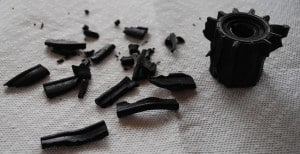
This is what a failed impeller looks like – the bits and pieces were once curved vanes that push raw water from the thru-hull intake into the generator. Once it fails, the generator doesn’t have cooling water, and the temperature sensor shuts it down. We really should be replacing these during our annual winter maintenance, but we didn’t know to tell our service yard to do it.
Kap began the impeller replacement job, but the first challenge was to find it. It’s in a different location on each generator model, and Mike didn’t know exactly where ours was. Using the Onan User’s Guide, she found a drawing of what it looked like, and finally spotted it on the outside face of the generator. She carefully removed the three screws holding it in place, and as Mike directed, pried the cover off. The impeller inside was totally destroyed – at least the blades were all destroyed. We saw immediately, though, that the spare impeller we had was not the same size – turns out it came from our old Nordic Tug, and thinking the impeller on the next size up generator would be the same, we’d kept it as a spare. Bad idea.
By now, Happy Hour was in full swing across the dock from us, and I went across to see if anyone happened to have an impeller like the one in my hand. No one had one exactly like it.
Go figure! Two generator failures in the same afternoon, and we’re at Kwatsi Bay Marina where they don’t have shore power. We were running on the house bank batteries throughout the day, and that’s the reason the WhisperGen had come on in the first place – to get them charged back up. Now we didn’t have either generator to get our batteries charged, and we had a long night to go before we could leave to get service help.
We started our main engines up to give us electricity to run some galley appliances, and I managed to get a light dinner fixed up. Then, after shutting down absolutely everything we could think of to lower our batter drain – including the fridge/freezer – we went to bed about 8PM. Our new plan was to depart Kwatsi Bay shortly after daybreak and head for Port McNeill – the closest place for any chance of repair help.
This is the reason the two main engine start battery banks are separated from the house bank – we’d still be able to start our engines in the morning even if we completely drained our house bank. We were even more glad now that we hadn’t taken Hinky down to set prawn traps, as we’d then have to contend with the power requirements of getting the dinghy back up on the upper deck. Oh, the things you learn when you’re cruising – they’re enough to fill a book.
Tuesday, August 23th, Kwatsi Bay Marina to Port McNeill Fuel Dock Marina
Bright and early – actually, just after daybreak – we started the main engines, and trying to be as quiet on the dock as we could so as not to wake up anyone around us, we slipped the lines, motored out of Kwatsi Bay and headed back up Tribune Channel.
At 8AM I called Brian Coverely at Delta Marine in Sidney to give him the news of our latest dilemma and to find out if he could arrange an air shipment of a replacement impeller – and if possible, personally courier it up to us, as he’s the primary service guy for WhisperGen in Canada. Based on the symptoms of heavy smoke, Brian figured the problem was due to a clogged filter screen. With the new impeller and filter screen, we could get both generators fixed.
Brian said no problem – if we’d foot the bill of a round trip flight, he’d have a guy on a plane first thing next morning to meet us at Port McNeill.
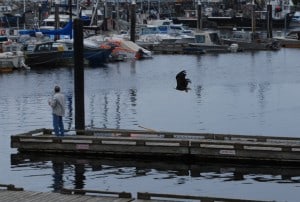
Our friend, the fish-gut mooching eagle was still around. He was hoping this guy on the end of the dock had some fish to throw in the water for him, but he was disappointed and flew on.
At Port McNeill we linked up with the Couverden again, but only with Steve on board as Shirley had gone back to Port Angeles to care for her mother. We hoped to be in port for the next day, and leave the day after that.
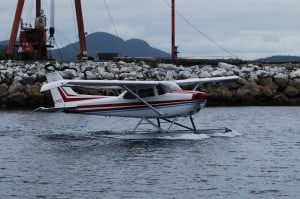
Our mechanic, Kevin, from Delta Marine arrived just before lunch the day after our arrival in this chartered floatplane. We didn’t ask the price for the charter (we didn’t want to know).
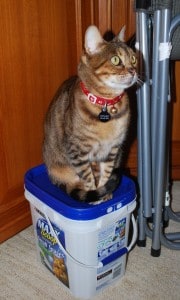
ZuZu’s a happy cat when she has a fresh container of kitty litter – well, actually, she hates using a litter box, and she’s happy when she can sit on whatever is around that’s the tallest off the floor . . .
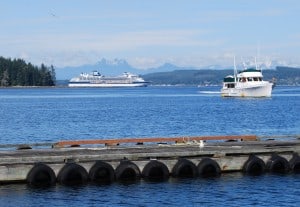
A Celebrity Cruise ship (you can tell by the large X on the funnels) passes by Port McNeill harbor on its way home to Seattle from SE Alaska.
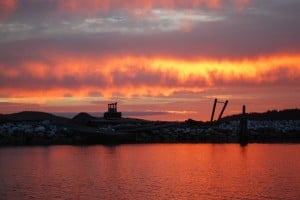
Sunsets at Port McNeill just got better and better – this one looked like the clouds were on fire (and I didn’t Photoshop this in any way!). We’re looking to the northwest, and the equipment in the foreground is heavy machinery on the breakwater that’s used to build up log booms on the other side from us.
Next morning, our mechanic from Delta Marine arrived by private floatplane charter from Sidney – a young guy named Kevin. He had the right impeller, and after getting it installed and the generator back up and running, gave Kap a good lesson in impeller replacement (for future reference). He also had with him a filter screen for the WhisperGen, and had it replaced in about a half hour – again, if we’d known, it would have been an item replaced last winter during our normal annual maintenance.
Unfortunately, the weather forecast on Johnstone Strait for the next day was high NW winds, and we’d not only be bucking a current, but would also have wind against waves which kicks up sharp waves that really beat you to pieces. We decided to wait out another day. We had plenty of time to spare in our schedule, and this made life quite easy.
Friday, August 26th, Port McNeill Fuel Dock to Blind Channel Marina
It’s a long slog down Johnstone Strait to Blind Channel Marina, so we decided to get an early start – 7AM. Kap’s float plan gave us an estimated arrival time of 1PM – a cruise time of six hours at 9 knots – but you never know if you’ll get some favorable current that you aren’t expecting.
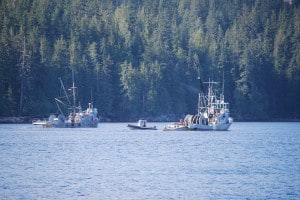
It was a commercial fishing open day, and the fishing fleet was out in droves – some trolling (the boat on the left), and others seining (the boat on the right). The boat on the left has an empty seining spool on his aft deck, and you can see trolling lines stretching back from the outriggers on each side. The boat on the right has his seining net still on the spool on the aft deck, and his “little boat” is just heading out to spool out his net.
Along the way, we passed dozens of commercial fishing boats – more than we’ve ever seen on Johnstone Strait, so it must have been one of the rare open fishing days for the commercial guys. You always have to keep a sharp eye out with the fishing boats, as some have fairly long trolling lines in the water and you need to make certain you don’t run over one of them. The seiners are more problematic, as they put out large nets – several hundred feet long, with an orange buoy at the end farthest from the big boat, and the net is kept at the surface with a string of small white buoys – and while it sounds like it’d be easy to see, they aren’t. We got lots of practice with this going to SE Alaska in 2008, so we know what to watch for.
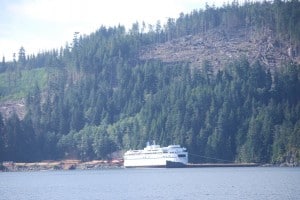
The larger logging camps have surprising camp housing – this one on Johnstone Strait near Salmon Bay is an old B.C. Ferry that’s tied up to shore. Given that this was built to be a passenger/car ferry, it would be interesting to see what the inside is like. It’s been there in the same spot for at least two years, so they must also be logging in the hills behind, then hauling the logs over to Johnstone Strait to float them out.
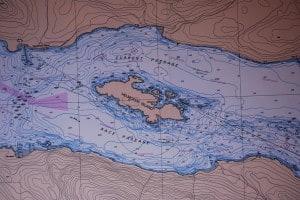
Just past Salmon Bay sits Helmken Island, smack in the center of Johnstone Strait, with Current Passage on the north side for boats going that direction, and Race Passage on the south for boats heading south. Those two names are very apt – as the current runs strong whether it’s flood or ebb. Notice the little oblong marks at the left and right side of the chart image – that indicates whirlpools and rips . . . and they mean that too!
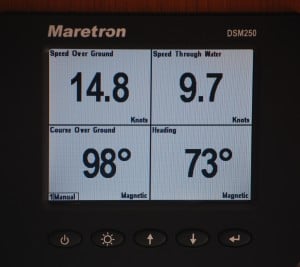
As our Maretron readout shows, we were definitely scooting along in Race Passage, helped by the current going with us. The upper right window indicates were going 9.7 kts through the water, but the GPS in the upper left indicates were going 14.8 kts over ground. Just before I got the camera up for this photo, it was showing 15.5 kts – indicating almost 6 kts of current! Our cruise to Blind Channel just got shorter.
For the most part, Johnstone Strait was behaving itself – light winds, less than 1’ wave chop, and the current running with us most of the way. We pulled into Blind Channel at least an hour ahead of our estimate.
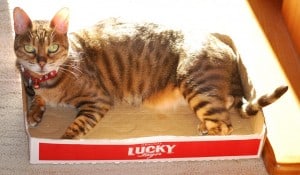
Once in Blind Channel and the engines are shut down, ZuZu is again a happy camper. You can buy some cats all kinds of toys and beds, and they still prefer an old grocery sack or a cardboard box top. If she’s not in her bed, you can usually find her sitting or lying in this box top.
An outdoor BBQ lunch was still being served on the patio when we arrived, so as soon as we got Flying Colours tied up we went ashore and had a light lunch and a much-needed beer. We didn’tneed much in the way of provisioning, but in this part of the world, when you get to a General Store, the temptation is great to buy more than you need – and I’m sure I did.
Since we were staying two nights, we made dinner reservations for the Blind Channel restaurant for the first night, and at Cordero Lodge the second night (gotta’ get one last fix of a really good Cordon Bleu schnitzel). Outside of that, most of the time during the two days was spent just lounging around and resting up.
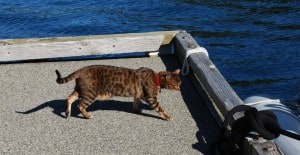
When she’s not falling overboard, ZuZu is allowed off the boat and on the dock a bit more now – provided we don’t see any evidence of eagles around (i.e., none sitting in treetops, and none of the telltale pipsqueak sounds they make.
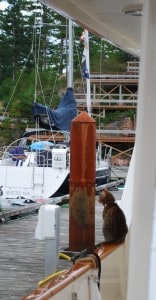
OK, OK, I take too many photos of ZuZu . . . but she’s just so photogenic almost every time I see her. Besides, she doesn’t object to having her picture taken like some other people I know. Here we’re at the SYC Cortes Island Outstation, and ZuZu is just itching to jump off on the dock and go exploring.
Sunday, August 28th, Blind Channel Marina to SYC Cortes Bay Outstation
Departure and cruising times were completely centered on slack water at the three rapids we’d have to get through, one after another – first Dent Rapids, then the rapids around Gillard Island, and finally the Yuculta Rapids. Slack was scheduled for 10:30AM, so Kap set our departure time at 9AM. As usual, Kap plugged in our cruising speed at 9 kts, but with a push from the current we got there almost a half hour early. There were four or five boats already setting up a single file stream to go through, and we got in line.
Devil’s Hole was a non-event – barely a ripple on the surface, which is the way it should be if you plan it correctly. Going through the rapids at Gillard Island, we had some difficulty with an inexperienced (or dumb) cruiser who couldn’t seem to get the hang of keeping up speed and staying on course, which always riles Kap – she doesn’t accept fools lightly in situations like this.
The cruise southward on Calm Channel was quiet, peaceful, and gorgeous weather – maybe even a bit too warm. We arrived early afternoon at Cortes Bay, hoping it wouldn’t be full of boats – it wasn’t . . . maybe four total. By the end of the day, though, the place had filled up, and if any more than two additional boats had arrived we’d have to raft together to get them in.
The next day was spent mostly with prawning – pulling the traps first thing in the morning, then again at midday, and the third time in the late afternoon. We’d set them at our usual spot, about a mile outside of the bay and just offshore of Twin Islands. It wasn’t the most productive that we’ve had, but we managed to get 120 prawns – still not up to our limit, but getting closer.
Shelling the prawns had to wait a day, as I had a flight home on Kenmore Air booked for the 30th. It was a very quick trip, down on the 30th, then spent all day the 31st on mail and paying bills, plus picking up Gator from Camp Kelly and getting him to a vet appointment for a lame front shoulder that had been plaguing him. He then returned with me to Cortes Bay on the 1st.
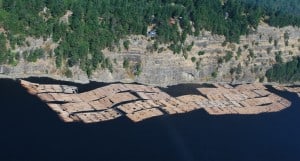
South of Nanaimo, and just before Dodd Narrows, is a log boom assembly area. Every time we pass we see tiny tugs zipping around as they move large numbers of logs into position and forming up the log booms. This time, I got a bird’s eye view of it from the Kenmore Air flight as we passed southward.
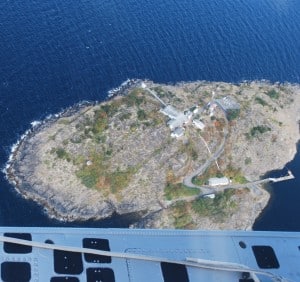
On my flight home, I managed to get a quick photo of Winchelsea Island on our approach to Nanaimo. This is a Canadian Naval communications station that controls Whiskey Golf, the torpedo test range in the Strait of Georgia.
An interesting anecdote on my flight south. While researching the Canadian Forces Whiskey Golf torpedo test range in the Strait of Georgia for one of my earlier blog posts, I ran across a blog (http://threesheetsnw.com/blog/archives/15980) that mentioned a discussion the guy had with a Canadian Forces officer stationed on Winchelsea Island, where the range is managed and where we monitor radio communication as we’re passing outside the perimeter on “active” days, or crossing through on “not active” days. One quote was really good: “He said the military has equipment that can clearly see you “picking your nose” from more than 20 nautical miles away, and that every square inch of the range is monitored electronically.”
What’s interesting about that was, in 2008 Kap and I were heading south from Sitka, AK. In our Nordic Tug, Cosmo Place. A 110’ U.S. Coast Guard cutter, the Anacapa, was approaching us from the rear – and this was after we’d been on the VHF channel 16 several times, giving our boat name – Cosmo Place – each time – which is in 18” tall letters on our transom.
We heard the Anacapa call several boats behind us giving them warning that she was traveling at high speed (35 knots) and to beware of her large wake. As she came nearer to us, I mentioned to Kap, “I wonder just how good their binoculars are on the bridge of a vessel like the Anacapa – I’ll bet they can see the rivets (if we had any) on the hull of Cosmo Place.” No sooner had I gotten that out of my mouth than we heard a radio transmission, “Castro Place, this is the Coast Guard cutter, Anacapa, approaching from behind, traveling at high speed and you should keep a watch out for our wake.” I responded to their transmission, saying our name as Cosmo Place, and they closed the communication by again calling us Castro Place. So much for the long eye prowess of the U.S. Coast Guard – maybe the Canadian Forces use a better version of binoculars.
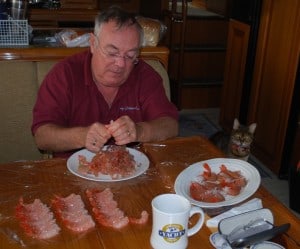
ZuZu has developed a strong interest in my prawn shell peeling each day after we pull our traps. As I finish shelling a plate of prawns, I pour the “prawn nectar” into her food bowl in the cockpit and she gets to slurp it up. It’s her contribution to the effort, and she knows what’s coming as soon as I start peeling –positioning herself nearby to make certain I don’t forget.
In the afternoon we took Gator for a walk on the remote road leading out of the outstation, picking a good bunch of ripe blackberries by the road – enough for three night’s dessert.
Saturday, September 3rd, SYC Cortes Bay Outstation to Prideaux Haven in Desolation Sound
The solitude of being at anchor in a beautiful bay was calling to us, and we departed Cortes Bay and headed for Prideaux Haven in Desolation Sound. Along the way, we stopped at Refuge Cove to take on a small amount of provisions (primarily milk for lattes) for a hoped-for long stay in Prideaux Haven.
After tying up at the fuel dock in Refuge Cove, we left Gator as usual in the salon while we made a quick trip to the General Store. On our return, I immediately spotted a large pile of bread crumbs on a sweat shirt laying on the salon settee – and quickly realized it was from a half loaf of artisan Parmesan Cheese bread that I’d left out on the galley counter. He’d snagged the plastic wrapper and hauled it down to the settee, where he gobbled up all but a few crumbs. He’s regressing to puppy habits, and we’re flummoxed about how to handle it.
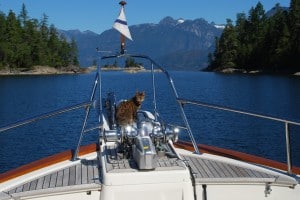
At the windlass, ZuZu helps us find the best anchorage in Prideaux Haven. This has to be one of the most spectacular places in the world to be on the anchor.
Within minutes of getting our anchor down, we lowered Hinky, readied the prawn traps, and headed out to drop them along the Mary Island group just outside Prideaux Haven. We knew from experience last year that finding the exact right spot was critical to our success, so we cruised around and marked each of the several 300’ deep holes with our GPS. We dropped our traps, figuring we’d return in the late afternoon to see if this spot was working. It was, but only a little – we had a total of 35 prawns when we pulled. We decided to drop for the night in another nearby hole.
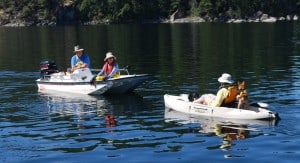
Kap took Gator for a cruise around Prideaux Haven in the kayak, meeting up with Steve and Shirley from Couverden.
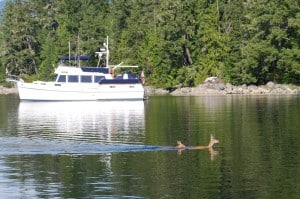
One afternoon I popped my head outside to see where ZuZu was and spotted a doe with her fawn swimming by about 25' from Flying Colours, heading from one small island to another that surrounds Prideaux Haven. The shoreline all around is lined with steep rock banks, and I wondered what they would do. Without missing a beat, the doe found the only spot in about 300’ to get ashore. They scrambled up the rocks with ease, and in an instant were out of sight in the dense trees.
Next morning, we had the best pull of our stay – 85 prawns – but Kap wanted to find still a better spot, so we put them back down in another hole. Unfortunately, we didn’t mark with our GPS the spot we’d just left, and for the remainder of our stay, we couldn’t locate it again. For the 10 total pulls we had here, the average number of prawns in each was 50 – which isn’t shabby, but not as good as we expected. It also brought us to a total of 791 total prawns on board – and with a possession limit of 800 for our two licenses, that’s about as close as you can get and still be legal. We decided it was time to call it quits for the year – particularly since our bait ran out just as we hit our limit, and on the day we decided was our last for the season.
A day after our arrival, Couverden pulled in and anchored near us. Each day, about a dozen boats at anchor would depart, and by day’s end another dozen would come in. Most nights, we had around 15 boats anchored in Prideaux Haven, and to us, that seemed a lot for this late in the cruising season. In late July, early August, though, there are several times that many, and it’s said you can almost walk from one boat to another. We expected it to be a lot less this year, but with the late summer that we’ve had, cruisers must be heading out late, or staying out late – we couldn’t tell which. We’ve decided next year we’ll try to arrive here in April, get our prawning done when the season is young and no other boats are around.
Thursday, September 8th, Prideaux Haven in Desolation Sound to SYC Garden Bay Outstation in Pender Harbour
It had been a wonderful five days in Prideaux Haven, but something told us it was time to begin our cruise south. We need to be in Sidney, B.C. by the 18th for some work to be done the following week on Flying Colours, so why not spend it cruising slowly, and maybe hit a few places we’ve never been before.
We were up at daybreak, getting Gator ashore one last time and raising Hinky on board before heading off at 7:40AM for a 5-hour cruise down Malaspina Strait. Our destination was the SYC outstation at Garden Bay in Pender Harbour. The Couverden had departed a couple of days earlier, and were waiting there for us – this would be our last link-up with them for the summer.
The current was against us on Malaspina Strait, but fairly benign, and we had a smooth and pleasant cruise south. We arrived in Pender Harbour on schedule at 1:30PM. After a quick visit to the grocery store to replenish milk for lattes, we had a last Happy Hour with Steve and Shirley, proving once again that no summer is endless.

